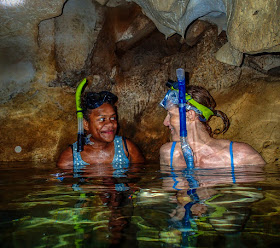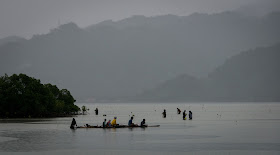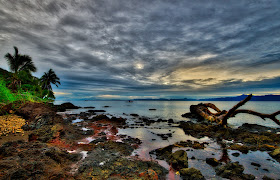We made the jump from Yadua Island, just off the western end of Vanua Levu, the northern of the two main islands of Fiji, to the Yasawa chain of islands that stretch down the western side of Fiji to the Mamanucas.
It was a brisk sail, in about 25 knots of wind. We used the No 2 genoa alone, without mainsail, and surged along at 7-8 knots. We caught a nice Spanish mackerel of about 10 kg. Fifty nautical miles to Sawa I Lau island. We left early, at 6.30 am, because we always like to arrive at new destination when the sun is still high, which makes it easier to see any reefs.
Nimrod under the cliffs of Sawa I Lau
The Yasawas are on the tourist circuit; cruise ships and resorts mix with relatively poor traditional villages.
Some of the limestone formations were similar to The Pinnacles in WA.
We went ashore to present sevusevu, and were guided by Moses
Tui, Amelia and Barbara.
The chief was not available, so we presented it to a senior woman Tui, who took it for him.
Tui's grand-daughter Barbara
Amelia plaiting a pandanus mat
Moses cooked us some crabs
Kids watching from the door
George and local boys
The island of Sawa I Lau contains some amazing limestone caves, some of which require that you swim through a tunnel underwater. We were taken through by a guide called Esther.
Esther at the first cave.
Esther and George in the inner cave
From Sawa I Lau we went round to Nanuya Resort in Blue Lagoon. It looks to us as if it is being over-capitalised by a wealthy bored Australian truckie from the Gold Coast. Lots of earth-moving noise in the night.
Next to Somosomo Bay, which was quiet and peaceful.
Then further south to Drawaqa Island, famous for the option of snorkelling with Manta Rays. They tend to feed in the mornings around the time of high tide. So we set off in the RIB at daybreak, and spotted some tell-tale wing-tips breaking the water. George drove the RIB upstream of them and I jumped in with my wetsuit and snorkel gear.
Now this is not actually my photo, though this is very similar to what I saw. But in the excitement of a 5 metre wing-span monster coming right at me with a huge mouth wide open, I was so distracted by thoughts such as: 'What is the evidence that they are gentle vegans?' that I managed to press the wrong button on the underwater video camera. So when I got back to our boat excited that I was sure to get a contract from David Attenborough, it was something of a let-down to find that there was nothing on the camera! Bummer!
The staff of the Barefoot Resort were friendly. They had a staff volley-ball match at sunset. It was of an impressively high standard. Fiji just won a gold medal at the Rio Olympics, and ball-sports are a source of much national pride.
Sunset through trees broken by Cyclone Winston
Waya Island
Kids welcoming us to Nalauwaki village
We presented sevusevu to Tamatai, chief of Nalauwaki village
Nimrod under Mount Nakaukau
See that peak up there? Way too high to think of climbing, right? Well pressure appeared, and offers of a guide. Comments designed to make one feel a wimp if one didn't; you know the score?
So off we set, with Ame the guide.
Walking through the village on the way to the mountain, we saw this young couple with their baby having breakfast on their deck by the beach.
George and Ame tackle the summit
Sir George Hillary and Sherpa Ame
View from the summit
Nimrod in Nalauwaki Bay























































